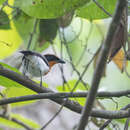Biology
provided by Arkive
Like other bush-shrikes, this orange-breasted species is a rather shy bird, preferring to remain in dense cover (3). African bush-shrikes feed mainly on a diet of large insects and even small rodents (4).
Conservation
provided by Arkive
It is possible that the orange-breasted bush-shrike may occur within the Kisama, (or Quiçãma) National Park (2), although even within this supposedly protected area there are continuous problems with illegal cultivation, cutting and other pressures from the human population inhabiting the park (5). There are currently no known conservation measures in place for this Endangered species, although it has been recommended that surveys to determine the distribution and population size of the orange-breasted bush-shrike, along with assessments of the current extent of forest cover, should be undertaken once the civil unrest in Angola subsides (2).
Description
provided by Arkive
This rare forest-dwelling bird is named for its vivid orangey-red breast. The orange-breasted bush-shrike also wears a 'cap' of rust coloured plumage on top of its head, which, along with the bright breast, contrasts with the black upperparts and white lower underparts. A white line also streaks across the black wings (2). The orange-breasted bush-shrike can be highly vocal, and calls with a throaty 'waark' and 'whoook', or with a soft, whistling 'bou-bou' (3).
Habitat
provided by Arkive
The orange-breasted bush-shrike inhabits secondary forest and forest alongside rivers and streams, where it occurs in dense, tangled undergrowth (2) (3).
Range
provided by Arkive
Endemic to north Angola, the orange-breasted bush-shrike is known from only three sites, in the provinces of Cuanza Norte and Bengo (2).
Status
provided by Arkive
Classified as Endangered (EN) on the IUCN Red List 2007 (1).
Threats
provided by Arkive
The region of Angola inhabited by the orange-breasted bush-shrike has been subject to steady deforestation in recent decades, with an increase in slash-and-burn cultivation and the removal of timber trees. As the orange-breasted bush-shrike is known from only a small area, this habitat destruction poses a great threat to the species' survival (2).
Braun's bushshrike
provided by wikipedia EN
- license
- cc-by-sa-3.0
- copyright
- Wikipedia authors and editors
Braun's bushshrike: Brief Summary
provided by wikipedia EN

Braun's Bushshrike
Braun's bushshrike (Laniarius brauni) is a species of bird in the family Malaconotidae. It is endemic to Angola. An alternative name for this bird is the orange-breasted bushshrike, but the English name is also used for Chlorophoneus sulfureopectus.
Its natural habitat is subtropical or tropical moist lowland forests. It is threatened by habitat loss.
The common name and Latin binomial commemorate the German collector R. H. Braun who collected in southern Africa.
- license
- cc-by-sa-3.0
- copyright
- Wikipedia authors and editors


 Braun's Bushshrike
Braun's Bushshrike